Sunday – Leominster – The water level in the River Lugg is still rising, the green grey water flowing rapidly. Last week very good number of large old cars luxury models in the Brightwells’ compound. This week there are smaller vehicles – a Fiat 500, a Renault 4, a 2CV and a delightful little three-wheeler, clearly some collectors are looking for these smaller models. More exclusive models are still here – a large Armstrong Siddeley, a Maserati Spider, a lovely timber-framed Morris Minor Traveller and an unusual much larger timber-framed car, an Austin Countryman. At the end of the line is a Morgan and a strange little continental vehicle which looking at it is hard to work out which way round it actually goes. The sky is grey and there is drizzle in the air, so unsurprisingly the market is quite small. And apart from a nurseryman selling wreathes there is surprisingly little Christmas stuff for sale.
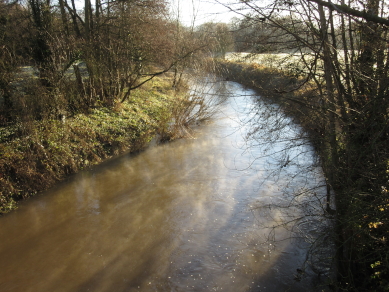
Tuesday – Leominster – A thin fingernail of the waning moon lies low in the eastern sky next to the brilliant diamond of Venus. The dawn will break soon. There has been a sharp frost. By mid morning the sun blazes down on pale frosty fields. Thin ghostly tendrils of mist drift across the River Lugg which is flowing rapidly still. A muddy path crosses the end of Easters meadow to the Mosaic Bridge. Into Millennium Wood. A Robin sings, Carrion Crows caw and a Blackbird mutters but the predominant sound is the roar of traffic on the A49. Horses are feeding in the misty paddocks at the foot of Eaton Hill, but the sun is rapidly burning the mist off. A Cormorant flies down stream. On to Eaton Bridge. A Grey Wagtail bobs on a Sallow twig over the water. On the other side of the bridge, on another Willow, a Robin puffed up against the cold watches the water streaming past. Over the A49 at the old A44 road to the disused bridge. A single Redwing is at the top of a stripped Hawthorn. The Manchester bound train passes under the bridge, slowing down for the station. Robins sing, Wrens tick and Blue Tits chatter. Long-tailed Tits at the top of a tree are chasing from branch to branch inspecting everything.
Wednesday – Bodenham Lake – The air is wet and chilly. A thick mist covers the area. There is hardly a squeak as I wander down the track. The paths and meadow are saturated. The far side of the lake is barely visible, which is unfortumate as I have actually remembered to bring my scope for once. A lone Moorhen swims near the scrape. Pheasants croak in the distance. Invisible Canada Geese call. A pair of Mute Swans are white blobs in the mist. There are duck towards the western end, Mallard and possibly a single Wigeon. At least three Cormorants are in the trees. Another flies in. A female Blackbird sits in a Hawthorn sapling. It departs and is replaced by a Robin which soon descends to the ground to search for food. The mist thins a little. There are two cygnets with the Mute Swans. A cock Pheasant struts along the top of the far bank. A drake Goldeneye is in the south western corner. There are a few Coot scattered around the water. Back through the coppice where the vivid green and yellow fallen Alder leaves are now brown and black and turning to mush. A Green Woodpecker flies up from the meadow. Very few apples remaining the orchards. One tree has a good number of very small apples which are unpleasantly sweet. A small flock of Redwings are feeding on Haws on the edge of the car park.

Sunday – Leominster – The sky overhead is clear and almost blue in the pre-dawn light, however there are heavy, grey clouds to both the east and west. It has rained overnight. A flock of Redwings flies west over the railway. Two Cormorants fly high, heading north up the course of the Lugg. A Raven is flying over even higher still. Robins are singing, Blue Tits chirping and House Sparrows chattering. A Wood Pigeon sits hunched in a tree watching the railway. Branches bounce as a Grey 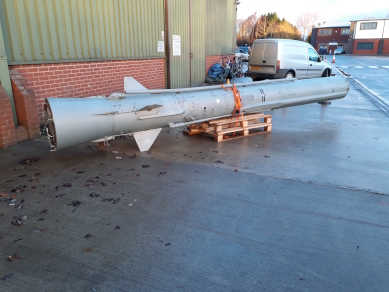 Squirrel scurries across the undergrowth and saplings by the track. A Mistle Thrush rasps and a Magpie voices its harsh whining in the Black Poplars beside the river. A Blackbird alarms as it flies across the river to join several others in a bush on the river bank. The river level is higher still; it is rising every week. Clouds to the south are edged with a golden orange glow as the sun rises above the hills. A small flock of Chaffinches flies into the last Hawthorn in what was once a hedge across Easters meadow. Several Rooks fly over, cawing quietly.
Squirrel scurries across the undergrowth and saplings by the track. A Mistle Thrush rasps and a Magpie voices its harsh whining in the Black Poplars beside the river. A Blackbird alarms as it flies across the river to join several others in a bush on the river bank. The river level is higher still; it is rising every week. Clouds to the south are edged with a golden orange glow as the sun rises above the hills. A small flock of Chaffinches flies into the last Hawthorn in what was once a hedge across Easters meadow. Several Rooks fly over, cawing quietly.
The market is small. A gaggle of seventeen Canada geese flies over in a V, high in the air. There have been several strange things outside Brightwells’ auction halls, but today is possibly the strangest – a Russian missile body, apparently according to Google, a Soviet Sinitsa 23, a target missile variant of the S-75 Dvina! Round to Paradise Walk. The level of the Kenwater is also high and it flows past rapidly.
Monday – Kidderminster – I park in a modern estate in the southern part of Kidderminster. The sun shines despite the scattering of cloud. A Robin is singing lustily. House Sparrows chirp. The road rises and crosses a bridge over the single track line of the Severn Valley Railway which is passing through a deep cutting. This was the GWR Loop Line. A couple of wagons are on a siding which, oddly, rises steeply up the side of the cutting. North of the bridge the house are early 20th century. Then they are much more modern again. Aggborough Farm stood here. Into a modern estate. Beyond is a large shed for engines or carriages. A line of carriages is moving  slowly alongside the shed but only the roofs can be seen over a tall fence. Back to the main road. After a short way, the housing reverts to earlier 20th century. Past Kidderminster Harriers football ground. A footpath runs along to a footbridge over the railway. Before the bridge is the entrance to the diesel depot. In front of the closed doors is a turntable and several diesel locomotives, a couple of shunters and a BR Class 33 diesel, 33108. The carriages seen earlier are being slowly pushed into the terminus station by a Class 9 diesel shunter D4100. The bridge also crosses the main Birmingham to Worcester line, the former GWR Oxford, Worcester and Wolverhampton line. A modern diesel multiple unit leaves the station and cruises the up line into a siding and then comes back out to head back to Birmingham. The shunter returns to the long shed having left the line of carriages in the station.
slowly alongside the shed but only the roofs can be seen over a tall fence. Back to the main road. After a short way, the housing reverts to earlier 20th century. Past Kidderminster Harriers football ground. A footpath runs along to a footbridge over the railway. Before the bridge is the entrance to the diesel depot. In front of the closed doors is a turntable and several diesel locomotives, a couple of shunters and a BR Class 33 diesel, 33108. The carriages seen earlier are being slowly pushed into the terminus station by a Class 9 diesel shunter D4100. The bridge also crosses the main Birmingham to Worcester line, the former GWR Oxford, Worcester and Wolverhampton line. A modern diesel multiple unit leaves the station and cruises the up line into a siding and then comes back out to head back to Birmingham. The shunter returns to the long shed having left the line of carriages in the station.
On the far side of the bridge is a car breakers yard. One car, possibly an old Humber, now sits alone in a thicket with saplings growing through it. The site is an old petrol station. Up the road, Chester Road South. The housing is a mixture ranging from late Victorian to modern. The main building of the King Charles I school dates from 1800-20 but was extended from 3 to 7 bays in the 1860s. Left onto Comberton Road towards the town centre. There are large Victorian houses here, mainly converted into flats. French Villa has an ornate pillared entrance on a fairly plain house 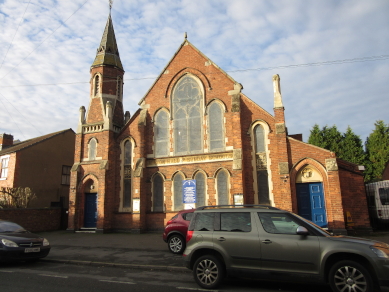 which was built in 1871 for Alphonse Joannin Bouët who came to Kidderminster in 1855 from Nimes, France, to work as a carpet designer for Brintons. Next to it is a greatly extended house with a square tower. Along Lorne Street. It is, unusually, numbered sequentially up one side then down the other. Milton Hall and Sunday Schools is the Baptist church dated 1890. The church and land were paid for by Joseph Peart Harvey, a corn merchant. He was prejudiced against churches and chapels, hence the name “Hall”. He handed the running of the hall over to a “committee of working men and women”. It became a Calvinist Baptist chapel in 1900. The street consists of Victorian terraces with the occasional named cottage. Into Offmore Road where the houses are dated to the 1880s.
which was built in 1871 for Alphonse Joannin Bouët who came to Kidderminster in 1855 from Nimes, France, to work as a carpet designer for Brintons. Next to it is a greatly extended house with a square tower. Along Lorne Street. It is, unusually, numbered sequentially up one side then down the other. Milton Hall and Sunday Schools is the Baptist church dated 1890. The church and land were paid for by Joseph Peart Harvey, a corn merchant. He was prejudiced against churches and chapels, hence the name “Hall”. He handed the running of the hall over to a “committee of working men and women”. It became a Calvinist Baptist chapel in 1900. The street consists of Victorian terraces with the occasional named cottage. Into Offmore Road where the houses are dated to the 1880s.
Back on Chester Road the cricket, hockey and Kidderminster Football ground with a large timber-framed pavilion. The grounds were opened in 1870 and occasionally host the Worcestershire County side when their ground floods. Houses here are dated to the 1870s. The bridge over the Birmingham line has a separate footbridge attached made by Tubewrights Ltd of Newport Mon. A substantial house in yellow brick, Stanmore House, is now a surgery. It was built in the late 19th century and called Linden House. In 1915 it became a school, “Miss Ivens’ Academy for Young Ladies”. In 1936 the house became living quarters for nurses. The road comes to a busy junction with the A456, Birmingham road. Another very large house on the junction is Land Oak. The buildings on the other corners are all modern. On towards the town centre down the Birmingham road. The Shrubbery, now a nursing home was probably built, around 1785, by William Lea (1741-1801). It was tenanted in the 19th century by members of the Talbot and Brinton families, both major manufacturers of carpets. Trinity Fields is a modern development of little architectural merit. The entrance gate posts and front wall to the estate were formerly the entrance to The Shrubbery. The main building of the Holy Trinity School still has the sign in stone, “Convent of the Holy Trinity” above the main door. Past St Ambrose’s Catholic church.
Into Leswell Street. Terraces are dated 1861 and 1896, some built by the Leswell Land Club. All spaces between then have been filled fairly recently. The old school built in 1890, now flats, retains a plaque, “One Lord, One Faith, One Baptism”. Through streets of late Victorian terraces. Into Lea Street where the Lea Street Board School of 1883 is still an education centre, although not a school. The street is still mainly terraces but towards the end, where the station lies across the road, there are several far more ornately decorated buildings. On the corner with Farfield is the Railway Bell, a Victorian pub. Back down to the footbridge and over to the football ground. (Thanks to Kidderminster Civic Society for some of the information above) Route
Home – At long last! The Russet Blue hen has laid an egg – a pretty pale blue one. She certainly has stretched the definition of point-of-lay!

Wednesday – Bodenham Lake – There are patches of blue overhead but most of the sky is obscured by clouds. A pair of Great Spotted Woodpeckers are chasing by the far orchard gate in what looks like a territorial dispute. Things seem to be picking up on the lake. A group of four Little Grebes are on the south side along with two female Goldeneye. A drake is a little further away. There seem to be a fair number of Coot and Mallard. However, there appears to be only three Wigeon present and nowhere near the usual number of Canada Geese. Half a dozen Tufted Duck are on the far side. Two Grey Herons are on the eastern spit and another flies past. Yet another is on one on the new mud banks. A pair of Mute Swans feed but there is no sign of the cygnets. A Moorhen appears from the reed bed. The three cygnets drift in from behind the small island. There is a lot of movement, the wildfowl seen edgy. Just a single Cormorant is in the trees. A couple in the hide ask about the Osprey nesting platform – something I had missed entirely. Sure enough a platform has been erected at the western end. There is a camera overlooking it. Fieldfares are noisy in the orchard, feasting on the last few cider apples. A Mistle Thrush calls as it flies through the other orchard. It is called Pen-y-llwyn in Welsh, Master of the Coppice.
Thursday – Leominster – Dawn arrives with a pale blue glow along the horizon but soon mutates into grey as frequent showers arrive. Yesterday I dug out the chicken run and scattered fresh shavings and straw. It is already wet and becoming compressed.
Hereford – Off to the city by bus. The River Arrow has caused flooding south of Leominster and beyond Dinmore Hill the Lugg has turned the fields into lakes. A rainbow arcs over the Burghope valley towards Kipperknowle.
Into the city centre. It is not a busy as I had expected. Widemarsh Street and High Town change every time I visit as businesses change, although some premises remain empty. Into Eign Gate where a large Pound shop is now empty. Even the cheapest end of the retail market struggles. There are several Polish shops here, although one has been closed by order due to the frequent prosecutions for selling illegally imported tobacco products. There is a market in High Town but one would be hard pressed to know it was a few days before Christmas.
Down to the River Wye and into the old bridge. The river level is high and grey-brown water swirls under the arches. Showers punctuate the grey dampness. Back on Blueschool Street, a Jackdaw chases a screaming Black-headed Gull, both ducking and diving until the Jackdaw seems to lose interest and glides away.
Friday – Ludlow – The Winter Solstice dawns grey, damp, windy but mild. The day now passes without hardly any interest, in contrast to its importance in far off times. Neolithic cultures recognised this as being the day following which the days started to grow longer – the promise of a returning spring and the rebirth of the land. Many of the stone circles across the lands had alignments which would indicate the dawn of the solstice. It was also one of the great feasts of the year as many beasts would be killed now, only so many could be fed during the hard winters so thinning the flocks and herds was essential. With limited preservation, eating the bounty was required.
Down to the station. A two-carriage unit which should have been retired years ago, speeds through, heading for Cardiff. As usual, all trains are running late, only by few minutes but nonetheless hardly ever on time. The trees by the River Lugg are nearly all devoid of leaves, with just a couple with dark brown leaves clinging on. Ash trees still have large bunches of keys and many have dense coats of Ivy. A Blue Tit chirps. Weirdly, to prove me and the indicator board wrong, the train turns up bang on time! A large flock of well over one hundred winter thrushes flies up from a pasture on Ridgemoor.
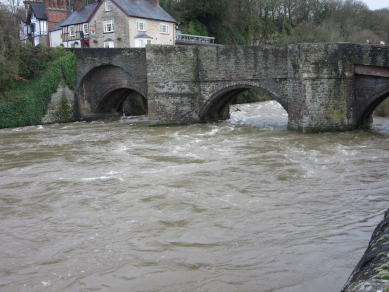
Out of the station. A pair of Carrion Crows are on the edge of the main car park. Both have white feathers on their backs. Up to Gravel Hill and down Lower Galdeford to Smithfield, once the cattle market which was on the site of the Priory, now a large car park. On down Weeping Cross Lane to the River Teme. Fine rain is whipped by the wind. Along Temeside. A terrace of houses are Edwardian, Ludford Parish Hall is dated 1906. The houses have delightful panels of Art Nouveau tiles by the entrances and the hall has similar period coloured glass in the top window lights.The river at Ludford Bridge is in spate, roaring over the weirs and swirling and churning by the bridge. Willows rise out of the pale grey water. Over the bridge and through the Charlton Arms car park with the intention of following the riverside path to Dinham Bridge but is has been closed off. Back over the bridge and up Lower Broad Street. Just beyond the Broad Gate is Silkmill Lane running parallel to the river through high some walls much repaired with bricks. A long workshop is at the end, seemingly now just a garage. Opposite is Broadgate Cottage, 18th century and once a row of cottages. Up Lower Raven Lane where the houses are a mixture of old and new. Many of the older ones are former coach houses and stables. The road continues up Raven Lane. Pelican Court is a strange, yet award winning, group of houses, some 16th and 17th century, others modern but very much in keeping with the group. On up the lane are small cottages, an old bakery and former shops dating from the 17th through to the 19th centuries. The lane emerges into Castle Square. The site was occupied by the Town Hall built in 1897 to commemorate the Golden Jubilee of Queen Victoria on the site of an older civic building. It was designed by Henry Cheer of Twickenham who also built Hereford Town Hall. The building was greatly disliked; Pevsner loathed it, and it was demolished in 1986. The site is now occupied by the market which is busy. It always seems strange that this market is at least three times the size of Leominster’s.
Christmas Day, Tuesday – Home – The morning is grey and damp. The house is full, the grandchildren noisy. We all visit the hens. The youngsters are laying regularly but neither of the old girls have laid for ages. I had to start early to get the turkey into the oven. Herefordshire had various Christmas traditions. One recorded by Ella Mary Leather from various sources was that no woman should enter a house on Christmas Day unless they slept the night before, or bad luck would ensue. No explanation is given for this somewhat strange idea. There are also sayings that if Christmas Day is windy or the sun shines there will be a good fruit harvest. Neither apply today!
Friday – Craven Arms-Clungunford – From the Discovery Centre car park the Shropshire Way, here called The Wart Hill Wander, passes through a modern estate and onto a muddy track. There is some blue in the sky and it is not cold. A pale moon is high overhead. The fields are full of sheep. Into a large field where the lines of grubbed our hedgerows can still be traced by trees, both large and small. The route runs parallel to the Heart of Wales railway line. An old Ash tree stands in the field. Its heart has completely gone, a large section of trunk had broken away and lies on the ground yet still some branches remain living, festooned with bunches of brown keys. Half a dozen Starlings sit on wires above the field. A Common Buzzard flies past, mewing. A Robin is in full song. A small pond is still, reflecting the sky. After several fields and stiles, the path reaches the Roman road, one of the extensions of Watling Street. I leave the Shropshire Way and head south-west along the road, here called Park Lane.
Across the fields, a single carriage train heads for Craven Arms on its way from Swansea to Shrewsbury. A large old apple tree has small yellow fruits. These trees have often grown from discarded pips and will not grow true to the variety that provided the pip but to the root stock. They are usually unpleasant eating. A Jay flies up from the hedgerow into Sallow Coppice. A small, old quarry lies just inside the wood. The ground here has numerous Hart’s Tongue Ferns growing on it. A Pheasant croaks. The lane rises steadily. Behind lie the Shropshire Hills, Long Mynd and Caer Caradoc. The lane crests the hill and starts to descend. The surrounding fields are empty. The sun blazes onset the edge of the hills, wet leaves gleam and the green grasses intensify in their verdancy.
Over a crossroads – one way to Onibury, the other to Broome. Flocks of Fieldfares fly over. Farmhouses and cottages are scattered across the landscape. Goat Hill rises to the west. At Crossways there is a small cottage and a lane turns off to Clungunford. A small domed reservoir stands beside the lane just before it drops down to the village. Further down a large Yew stands on the high bank above the lane. The church bell chimes. Into the village down School Lane. The dwellings in the lane are all modern. The old school is undergoing renovation. The school was an impressive building looking more like a church than school. The school was founded in 1682 by the trustees of Francis Walker and closed in 1988. Across the B4367, Craven Arms to Leintwardine road. Down a steep lane, Chapel Road, past a sports field, the old Post Office and the new Parish Hall. The Methodist 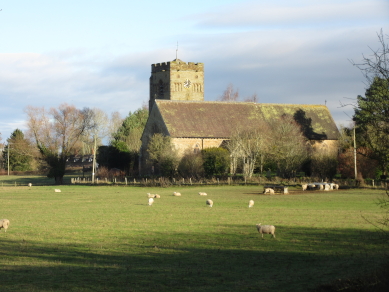 Hall stood here but was demolished in 1989. Most the houses are modern. Old barns stand before a junction beside which is Clungunford Farm. The farmhouse is 17th century with later additions. Into Church Road. A large house, Georgian maybe, stands opposite. The old Rectory is a large red brick house. The Rectory is modern. Opposite is a timer-framed house, now divided into two, dating from the 16th century. The church of St Cuthbert stands on the edge of the flood plain of the River Clun.
Hall stood here but was demolished in 1989. Most the houses are modern. Old barns stand before a junction beside which is Clungunford Farm. The farmhouse is 17th century with later additions. Into Church Road. A large house, Georgian maybe, stands opposite. The old Rectory is a large red brick house. The Rectory is modern. Opposite is a timer-framed house, now divided into two, dating from the 16th century. The church of St Cuthbert stands on the edge of the flood plain of the River Clun.
A path leads to the church through a large graveyards. A wooden cross stands on the base of the old churchyard cross. A fine carved Victorian wooden porch depicts St Cuthbert with his swans. Inside the church had been extensively restored. Chairs have replaced the pews. It is thought a wooden Anglo-Saxon church stood here. The village name derives from Gunnward’s Ford and the river is still called Gunnas by some locals. The stone church was started by Roger de Halberdine around 1305 but the roof was not in place until around 1330 (dated by dendrochronology of the roof timbers). By this time, de Halberdine had been bankrupted and it was probably the Earl of Arundel who paid for the church to be finished. 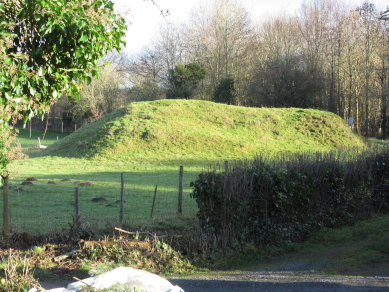 This period was a “mini-ice age” which impoverished the countryside. The window glass and the tomb of de Halberdine were destroyed in the Reformation. His wooden chest survives although it has been hidden behind chairs and kneelers! The major restoration took place in 1894 and was carried out by Edward Turner of Leicester, funded by John Charles Leverson Rocke of Clungunford House. The font dates from 1835 and is in Wenlock Marble and pulpit is by Turner. The East window is by Hardmans. The organ is by James Binns of Leeds.
This period was a “mini-ice age” which impoverished the countryside. The window glass and the tomb of de Halberdine were destroyed in the Reformation. His wooden chest survives although it has been hidden behind chairs and kneelers! The major restoration took place in 1894 and was carried out by Edward Turner of Leicester, funded by John Charles Leverson Rocke of Clungunford House. The font dates from 1835 and is in Wenlock Marble and pulpit is by Turner. The East window is by Hardmans. The organ is by James Binns of Leeds.
An elongated motte stands behind the 16th century Glebe Cottage beside the church. The builder of the castle is unknown, probably a minor knight.
On down the road to Clungunford Bridge, erected in 1935 to replace that built in 1657. Over the river is Abcott with the early 17th century Abcott Manor on the hill. Back up the road. Just before the junction with the B4367 are substantial stables for the late 18th century Clungunford House which is hidden behind trees. On the junction is the  Gardener’s Cottage. Opposite, hidden, is a large pool.
Gardener’s Cottage. Opposite, hidden, is a large pool.
Up the main road. A Red Kite is circling the river valley along with several Common Buzzards. A farmer is trimming the hedgerow. Into the hamlet of Broome. An early 17th century farmhouse, remodelled some years later, is one of the few older buildings on the way into the hamlet. Despite there being little older housing, Broome does boast a railway station, albeit a single platform with a tiny shelter. It is a request stop and opened in 1861. It had a staff of five, living in houses built for them – Railway Terrace. The old goods shed is part of a house. Siding rails are buried under the car park. There is also a village pub.
Out of the village and on along the main road. A short terrace is Victorian farm workers cottages stand at Broome Marsh. The road bends under the railway. The Shrewsbury bound train trundles past. A large pond lies beside the road shortly before it joins the B4368 at Long Meadow End. There are a few older cottages but more modern houses. A lane leads to Sibdon. A pair of estate cottages have a plaque, “HRH 1954”. The Wart Hill Wander leads across the fields back to Craven Arms. The Ash tree, I noted nearly four years ago, with the black fungus, King Alfred’s Cakes, Daldinia concentrica, is still there. On across the fields and into the new part of town. Down to the main road again and into the town centre. Route
Sunday – Leominster – Down the street. Overhead the sky is grey but there is some sun beams lighting up the houses facing south. The weather is mild again. Common Ink Caps, Coprinus astramentarius, rise from the pavement around a stump by the wall of the Baptist church. A Robin is  singing nearby, a Blackbird sits in a bare tree looking around before flying off towards gardens. Over the railway bridge. Beyond, three Magpies squabble in an Ash tree. Although it is Sunday, for some work continues. A mechanic, coffee cup in hand, starts work in the plant hire yard. East Europeans chat at the car wash, awaiting their first customer. A Song Thrush is in full flow beside the river. A Wren churrs from the undergrowth. The River Lugg is grey, swirling and flowing fast. Grey Wagtail flashes downstream. Tree branches glow in the brilliant morning sunshine. The bells of the Minster ring out calling the faithful. The quantity of vehicles in their compounds is greatly reduced. Long row ambulances, fleet cars and white vans and other cars. The vintage cars have all gone. There is no market now until March so the car park is empty.
singing nearby, a Blackbird sits in a bare tree looking around before flying off towards gardens. Over the railway bridge. Beyond, three Magpies squabble in an Ash tree. Although it is Sunday, for some work continues. A mechanic, coffee cup in hand, starts work in the plant hire yard. East Europeans chat at the car wash, awaiting their first customer. A Song Thrush is in full flow beside the river. A Wren churrs from the undergrowth. The River Lugg is grey, swirling and flowing fast. Grey Wagtail flashes downstream. Tree branches glow in the brilliant morning sunshine. The bells of the Minster ring out calling the faithful. The quantity of vehicles in their compounds is greatly reduced. Long row ambulances, fleet cars and white vans and other cars. The vintage cars have all gone. There is no market now until March so the car park is empty.
The banks of the river north of Ridgemoor Bridge are spotted white with Snow Berries. Yellow catkins hang beside red cones on an Alder. Round Paradise walk where House Sparrows chatter in the hedge. One emerges from a garden with a morsel from the bird table. The River Kenwater is fast.
New Year’s Eve, Monday – Leominster – Grey clouds cover the sky making the morning dark and dismal. Round to Westbury Street where there is a row of conifers from which a Great Tit sings its squeaky bicycle wheel song. Up Ryelands Road. Wood Pigeons sit motionless in trees and Jackdaws perch on chimney stacks watching. A Collared Dove sits in a tree; they are far less common these days, possibly because trichomonosis, a disease that only affects birds, spread from pigeons and doves to Greenfinches and other small birds, increasing its prevalence in the environment. It is thought that Collared Doves could be more susceptible to trichomonosis than Wood Pigeons, which are on the increase, and that the rise in disease incidents might be having an effect on the Collared Dove population. Pass the Toll House and round into the old orchard site, now a small housing estate. Into Cockcroft Lane now just the path. Robin sing from various directions. An old quarry lays below the path, a track up out of it is still visible. The hedges and bushes here are covered in ivy, the berries just beginning to ripen.
Out along the top of the ridge beside the open fields. The Arrow valley is scarred by the extensive polytunnels, which I thought were supposed to be removed during the winter. In the distance, steam rises from the chimney at Tyrrell’s crisps factory. The distant hills are hazy. Down to the Hereford Road and into Southern Avenue. A Song Thrush sings his little heart out on the edge of the town cemetery. Their larger cousins, Mistle Thrushes, fly over rasping. A large articulated lorry pulls out of the tyre dealers; it is from Turkey. Our tyre manufacturing industry has largely gone and it is now more economic, apparently, to transport tyres in a huge lorry right across Europe! A compound opposite brand new farm equipment, seed drills and similar, followed by rows of second-hand tractors then large grain wagons.
Into Worcester Road. Many businesses have remained shut after Christmas and will not open again until the new year. However the car washes are doing good business.
And so another year comes to a close. My rambles have been varied and enjoyable. Our life is very good when we compare things to what millions of other people are enduring. Sadly, it does not seem the world political is going to improve in 2019, but one can always hope.
To warm with life and be itself again?
Something about me daily speaks there must,
And why should instinct nourish hopes in vain?
'Tis nature's prophesy that such will be,
And everything seems struggling to explain
The close sealed volume of its mystery.
Time wandering onward keeps its usual pace
As seeming anxious of eternity,
To meet that calm and find a resting place.
E'en the small violet feels a future power
And waits each year renewing blooms to bring,
And surely man is no inferior flower
To die unworthy of a second spring?
John Clare